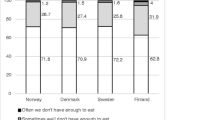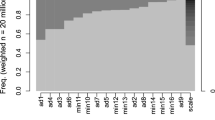Abstract
Within the extensive food insecurity literature, little work has been done regarding (a) the depth and severity of food insecurity and (b) the food insecurity of American Indians. This paper addresses both these topics with data from the 2001 to 2004 Core Food Security Module of the Current Population Survey. To measure food insecurity, three axiomatically derived measures of food insecurity are used. As expected, given the worse economic conditions facing American Indians, their food insecurity levels are generally higher than non-American Indians. However, the magnitude and significance of these differences differ depending on the choice of food insecurity measure.


Similar content being viewed by others
Notes
Given the differences between households with and without children and the differences in questions being asked (as noted above, the former are asked 18 questions, the latter 10), one may question whether the scales being used are unidimensional. In response, I use two sets of food insecurity scales used by previous authors—one that is restricted to the ten questions relevant for households without children and one that is restricted to the eight questions only asked of households with children. The results from these estimations are discussed below.
An analogy can be drawn with the educational testing literature where the Rasch model is often used. In that case, it would be presumed that no one question can reflect a student’s knowledge of, say, a particular subject, but rather a series of questions are needed to accurately portray his or her knowledge.
A household is said to be food secure if all household members had access at all times to enough food for an active, healthy life. Households are said to be food insecure if they were uncertain of having, or unable to acquire, enough food for all household members because they had insufficient money and other resources for food. Households are said to be food insecure with hunger if one or more household members were hungry, at least some time during the year because they could not afford enough food (Nord et al. 2004).
The percent of households responding affirmatively to zero questions is suppressed in the figures. If these values were included, in Fig. 1, 54.7% of American Indians responded affirmatively to zero questions and 74.8% of non-American Indians responded affirmatively to zero questions. In Fig. 2, the respective values are 71.5 and 85.9%.
The results for food insecurity with hunger are available from the author upon request.
Because a different set of questions are being used than in Table 1, the absolute values for α = 0 are not directly comparable across the two tables.
As done in the previous two alternative specifications, I estimate a new set of Rasch scores. These are available from the author upon request.
The coefficients on the other variables, the year fixed effects, and the state fixed effects are suppressed in Table 6 and subsequent tables but are available from the author upon request. These variables are of the expected sign and statistical significance.
References
Adams E, Grummer-Strawn L, Chavez G (2003) Food insecurity is associated with increased risk of obesity in California women. J Nutr 133:1070–1074
American Indian Studies Programs (2000) Bibliography of resources related to food assistance and health of North American Indians and Alaska Natives. University of Arizona, American Indian Studies Programs
Anderson S (1990) Core indicators of nutritional state for difficult-to-sample populations. J Nutr 120:1559S–1600S
Andrich D (1988) Rasch models for measurement. Sage, Newbury Park, CA, USA
Atkinson A (1987) On the measurement of poverty. Econometrica 55(4):749–764
Bhattacharya J, Currie J, Haider S (2004) Poverty, food insecurity, and nutritional outcomes in children and adults. J Health Econ 23:839–862
Bickel G, Nord M, Price C, Hamilton W, Cook J (2000) Guide to measuring household food security: revised 2000. US Department of Agriculture, Food and Consumer Service, Office of Analysis and Evaluation
Bitler M, Gundersen C, Marquis G (2005) Are WIC non-recipients at less nutritional risk than recipients? An application of the food security measure. Rev Agric Econ 27:433–438
Borjas G (2004) Food insecurity and public assistance. J Public Econ 88:1421–1443
Bourguignon F, Fields G (1997) Discontinuous losses from poverty, generalized \({\text{P}}_{\alpha } \) measures, and optimal transfers to the poor. J Public Econ 63:155–175
Casey P, Simpson P, Gossett J, Bogle M, Champagne C, Connell C, Harsha D, McCabe-Sellers B, Robbins J, Stuff J, Weber J (2006). The association of child and household food insecurity with childhood overweight status. Pediatrics 118:1406–1413
Che J, Chen J (2001) Food insecurity in Canadian households. Health Rep 12(4):11–21
Dunifon R, Kowaleski-Jones L (2003) The influences of participation in the National School Lunch Program and food insecurity on child well-being. Soc Serv Rev 77:72–92
Dutta I, Gundersen C (2007) Measures of food insecurity at the household level. In: Guha-Khasnobis B, Acharya S, Davis B (eds) Food security indicators, measurement, and the impact of trade openness: series: WIDER studies in development economics. Oxford University Press, Oxford (in press)
Feingold K., Pindus N, Wherry L, Nelson S, Triplett T, Capps R (2005) Background report on the use and impact of food assistance programs on Indian reservations. US Department of Agriculture, Economic Research Service, Contractor and Cooperator Report 4
Foster J, Shorrocks A (1991) Subgroup consistent poverty indices. Econometrica 59:687–709
Foster J, Greer J, Thorbecke E (1984) A class of decomposable poverty measures. Econometrica 52:761–766
Furness B, Simon P, Wold C, Asarian-Anderson J (2004) Prevalence and predictors of food insecurity among low-income households in Los Angeles County. Public Health Nutr 7:791–794
Gregory R, Abello A, Johnson J (1997) The individual economic well-being of Native American men and women during the 1980s: a decade of moving backwards. Popul Res Policy Rev 16:115–145
Gundersen C, Gruber J (2001) The dynamic determinants of food insufficiency. In: Andrews M, Prell M (eds) Second food security measurement and research conference, volume II: papers. US Department of Agriculture, Economic Research Service Food Assistance and Nutrition Research Report 11-2, 92–110
Gundersen C, Kreider B (2007) Food stamps and food insecurity: what can be learned in the presence of nonclassical measurement error? J Hum Resour (in press)
Gundersen C, Ribar D (2005) Food insecurity and insufficiency at low levels of food expenditures. Institute for the Study of Labor (IZA) Working Paper No. 1594
Gundersen C, Weinreb L, Wehler C, Hosmer D (2003) Homelessness and food insecurity. J Hous Econ 12:250–272
Hamilton W, Cook J, Thompson W, Burn L, Frongillo E, Olson C, Wehler C (1997) Household food security in the United States in 1995: technical report of the food security measurement project. US Department of Agriculture, Food and Consumer Service, Office of Analysis and Evaluation
Jolliffe D (2003) On the relative well-being of the nonmetropolitan poor: an examination of alternative definitions of poverty during the 1990s. South Econ J 70:295–311
Laraia B, Siega-Riz A, Gundersen C, Dole N (2006) Psychosocial factors and socioeconomic indicators are associated with household food insecurity among pregnant women. J Nutr 136:177–182
Leichenko R (2003) Does place still matter? Accounting for income variation across American Indian tribal areas. Econ Geogr 79(4):365–386
Martin K, Rogers B, Cook J, Joseph H (2004) Social capital is associated with decreased risk of hunger. Soc Sci Med 58(12):2645–2654
Mayer S, Jencks C (1989) Poverty and the distribution of material hardship. J Hum Resour 24:88–114
National Research Council (2005) Food insecurity and hunger in the United States: an assessment of the measure. National Academies Press, Washington, DC, USA
Nord M, Andrews M, Carlson S (2004) Household food security in the United States, 2003. US Department of Agriculture, Economic Research Service, Food Assistance and Nutrition Research Report 42, Washington, DC, USA
Office of Management and Budget (2000) Standards for defining metropolitan and micropolitan statistical areas. Fed Regist 65:82228–82238
Pattanaik PK, Sengupta M (1995) An alternative axiomatization of Sen’s poverty measure. Rev Income Wealth 41(1):73–80
Pheley A, Holben D, Graham A, Simpson C (2002) Food security and perceptions of health status: a preliminary study in rural Appalachia. J Rural Health 18(3):447–454
Ribar D, Hamrick K (2003) Dynamics of poverty and food sufficiency. US Department of Agriculture, Economic Research Service, Food Assistance and Nutrition Research Report 33, Washington, DC, USA
Sen A (1976) Poverty: an ordinal approach to measurement. Econometrica 44(2):219–231
Slack K, Yoo J (2005) Food hardship and child behavior problems among low-income children. Soc Serv Rev 79(3):511–536
Stuff J, Casey P, Szeto K, Gossett J, Robbins J, Simpson P, Connell C, Bogle M (2004) Household food insecurity is associated with adult health status. J Nutr 134:2330–2335
Tiehen L (ed) (2003a) Food assistance and nutrition research small grants program: executive summaries of 2002 research grants. US Department of Agriculture, Economic Research Service, Food Assistance and Nutrition Research Report No. 38
Tiehen L (ed) (2003b) Food assistance and nutrition research small grants program: executive summaries of 2001 research grants. US Department of Agriculture, Economic Research Service, Food Assistance and Nutrition Research Report No. 37
Van Hook J, Balistreri K (2006) Ineligible parents, eligible children: food stamps receipt, allotments, and food insecurity among children of immigrants. Soc Sci Res 35(1):228–251
Vozoris N, Tarasuk V (2003) Household food insufficiency is associated with poorer health. J Nutr 133(1):120–126
Wilde P (2004) Differential response patterns affect food-security prevalence estimates for households with and without children. J Nutr 134:1910–1915
Acknowledgment
The research in this paper is funded through a grant from the US Department of Agriculture, Economic Research Service through the University of Arizona, American Indian Studies Program. The views expressed in this paper are those of the author and do not necessarily reflect the views of the US Department of Agriculture. Previous versions of this paper were presented at the Annual Meetings of the Association for Public Policy Analysis and Management, at the RIDGE Conference at the Economic Research Service, and in a seminar in the Department of Agricultural and Resource Economics at the University of Arizona. The author wishes to thank participants at those venues for their comments. The author also wishes to thank Dawn Aldridge, Kenneth Finegold, Mark Nord, Dave Smallwood, Parke Wilde, and two anonymous referees of this journal for their comments and Katherine Burns and Brandie Ward for their research assistance.
Author information
Authors and Affiliations
Corresponding author
Additional information
Responsible editor: Junsen Zhang
Appendix
Appendix
Rights and permissions
About this article
Cite this article
Gundersen, C. Measuring the extent, depth, and severity of food insecurity: an application to American Indians in the USA. J Popul Econ 21, 191–215 (2008). https://doi.org/10.1007/s00148-007-0152-9
Received:
Accepted:
Published:
Issue Date:
DOI: https://doi.org/10.1007/s00148-007-0152-9




